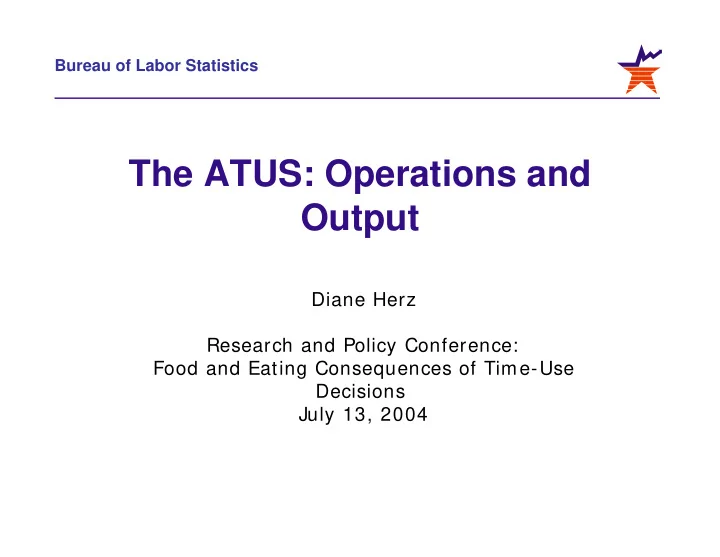

Bureau of Labor Statistics The ATUS: Operations and Output Diane Herz Research and Policy Conference: Food and Eating Consequences of Time-Use Decisions July 13, 2004
ATUS: Estimation objectives • Annual estimates of time spent in variety of activities • Measures for average weekday, weekend day, and week • Data by demographics and labor force characteristics • Continuously collected data • Multiple years’ data to increase pooled sample
ATUS: Sample 3-stage process: drawn from recently retired CPS: 1: CPS oversample in states is reduced; ATUS sample distributed in line with US states’ populations 2: Stratified by household characteristics: • Race (of CPS reference person) • Ethnicity (of CPS reference person) • Presence of children • Number of adults in adults-only households 3: Eligible household member is randomly selected for ATUS (the “designated person”), or DP
ATUS: Operations • DP randomly assigned a designated day (DD) about which to report • Advance materials sent directly to DP • Contacted on interview day for up to 8 weeks to secure one interview • Computer Assisted Telephone Interviewing (CATI) – English or Spanish – Census Bureau interviewers in Jeffersonville, IN DP reports about yesterday Designated Day Interview Day (e.g. Monday) (e.g. Tuesday) Core of interview: 24-hour diary (4am-4am)
ATUS: Structure of the survey Introduction Household Roster & Includes non-HH Employment Status own children Core Time diary Paid Work Summary Questions Child Care Volunteering Missed Days Labor Force Updates Future: Modules
Household roster screenshot
Diary software screenshot Question text Activities
Who was with the respondent? •At home: “ Who was in the room with you?” •Away from home: “ Who accompanied you?”
Note: Each leg of a trip is recorded as a separate activity Where was the respondent?
Summary questions: Work Some activities were work but weren’t identified as such in the diary: Others were income-generating activities other than for one’s job
Summary questions: Secondary child care •Calculate duration of time respondent had child(ren) under 13 in his or her care while doing other things. Consistency rules: •Respondent cannot be sleeping and providing care. •Respondent cannot be providing primary and secondary care at the same time (no double-counting). •Care must be done in the window between when first child under 13 got up and last child under 13 went to bed.
Summary questions: Volunteering • Added to enable coders to distinguish volunteering for organizations from care activities for individuals • Used CPS definition of volunteering
Summary Question: Missed Days Concern: 24-hour protocol means ATUS misses activities done on trips of 2 or more nights. Knowing how many trips and what type provides a general idea what we are missing.
ATUS Activity Coding • Nearly every reported activity is assigned a 6-digit code. • Each code represents 3 levels of detail. • System was designed to be analytically flexible. • Coders use all fields in diary to help them code. • Activities are coded twice. They are sent to an adjudicator if there is disagreement between coders. Sample from ATUS lexicon
ATUS Activity Coding: First Tier
ATUS Modules • Can provide in-depth information on a time-use related issue • 6-month minimum fielding • All questions must be tested and shown to elicit information desired • Suggested topics have included: – Food security – Travel & transportation – Child care (attitudes, concerns, expenditures) – Stress/experiences of “time crunch” – Health – Care of elders and/or disabled
Press release • First estimates will first be released in a press conference/release • Microdata files will follow • Advance documentation available now: – User-friendly questionnaire document – Draft datafile codebook
Data file formats • Microdata files delivered by Census for time-use estimation (subset provided to the public) ATUS CPS File Contains all public-use CPS month-in-sample 8 information for DP and household members. Includes all sampled households, regardless of whether they completed ATUS. ATUS DP File Contains variables collected in ATUS for which there is one value for each DP (e.g. employment status, total time providing secondary child care). Also person-level weights. ATUS Roster File Contains updated roster information--age, sex, and relationship to DP for each person in household. Plus non- household children under 18. ATUS Activity Includes activity-level information collected in ATUS (e.g. (Episode) File activity code, location, duration, start/stop times, if childcare was done during the activity). ATUS Who File Includes who was present during each activity. One record for activities done alone and multiple records for activities with multiple people present.
Data file formats • Summary file developed by BLS from Census files ATUS Summary File Will contain summary-level activity information for each respondent (e.g. total time working) and major demographic variables.
Data file formats • Files for examining survey methodological issues ATUS Missed Days Contains information collected in an ATUS summary question File on # and purpose of trips (> 2 nights) away from home in the month prior to the first designated day. Data may be used to get at potential bias because ATUS asks about “yesterday” activities. ATUS Case-level Contains collection and coding data for which there is one Operations Data value/case (e.g. final outcome code and interviewer length). File ATUS Call-level Contains collection and coding data per call attempt (e.g Operations Data interim outcome codes, scrambled interviewer ID, and call File time)
ATUS Contact information Website: www.bls.gov/tus E-mail: ATUSinfo@bls.gov Phone: 202-691-6378
Recommend
More recommend